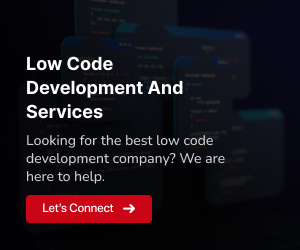In the dynamic landscape of technology, businesses are continually in pursuit of innovative solutions that enable agility, efficiency, and rapid adaptation to evolving market demands. Amid this quest, the emergence of high-performing low-code solutions has sparked a revolution, transforming the traditional paradigms of application development. Low-code platforms empower businesses to create robust, scalable, and feature-rich applications with unprecedented speed and ease, ushering in an era of unparalleled digital transformation.
1. Intuitive User Interface: Navigating Complexity with Simplicity
The hallmark of a high-performing low-code solution is its ability to transform intricate coding tasks into a seamless, intuitive experience. Imagine a workspace where complexity dissolves and creativity flourishes. Such platforms sport a user interface akin to an artist’s canvas, where developers, regardless of their technical prowess, can effortlessly drag, drop, and connect elements. This intuitive approach democratizes app creation, bridging the gap between technical and non-technical stakeholders.
In this environment, building applications becomes akin to crafting a digital masterpiece. Users interact with an array of visually intuitive modules, each representing a powerful functionality. Dragging these modules onto the canvas and connecting them feels like assembling building blocks. The interface responds in real time, offering suggestions, highlighting potential connections, and providing instant feedback, much like a mentor guiding a student. This dynamic interaction transforms the traditionally daunting task of coding into an engaging, visually stimulating experience.
Furthermore, the intuitive user interface extends beyond mere aesthetics. It’s about more than just making things look good; it’s about making them work seamlessly. High-performing low-code platforms invest in meticulous UI/UX research, ensuring that every button, menu, and element is placed intuitively, optimizing the user’s workflow. The result? Developers can translate their ideas into functional features with unparalleled speed and precision.
2. Scalability Beyond Limits: Adapting to Your Business Growth
High-performing low-code solutions are engineered with scalability at their core. They understand that today’s solutions might need to handle a hundred users, but tomorrow, they might need to accommodate thousands, if not millions. Scalability in the low-code realm transcends the traditional boundaries of applications, ensuring they can seamlessly grow alongside your business.
In scalability, these platforms operate on a principle akin to elastic architecture. Much like a well-designed building that can expand its floors as the need arises, high-performing low-code solutions allow applications to grow organically. Whether your business experiences a sudden surge in users, an expansion to new markets, or an influx of data, a robust low-code platform adapts effortlessly.
Elastic Modules:
High-performing low-code platforms offer a modular approach to application development. Each function, feature, or service exists as a self-contained module. When scalability demands arise, these modules can be replicated, fine-tuned, and deployed across a broader spectrum without disrupting the existing architecture. This modular design ensures that your application isn’t a monolithic structure but rather a collection of interconnected modules, allowing for independent scaling.
Automated Scaling:
Imagine an application that understands its workload. High-performing low-code solutions incorporate intelligent algorithms that monitor user interactions, server loads, and data processing speeds in real time. When the system detects an increase in demand, it automatically scales the resources – be it servers, databases, or processing power – to ensure a seamless user experience. This automated scaling isn’t just about managing peak loads; it’s about optimizing resources in real time, ensuring cost-efficiency without compromising performance.
Future-Proofing Through Scalability:
One of the defining traits of high-performing low-code solutions is their ability to future-proof your applications. Technology evolves at a rapid pace, and what works today might be obsolete tomorrow. Scalability in the context of low code isn’t just about handling immediate growth; it’s about ensuring your applications remain relevant and efficient in the face of technological advancements. These platforms seamlessly integrate emerging technologies, ensuring your applications are ready to embrace innovations such as AI, IoT, and blockchain without undergoing a complete overhaul.
Global Scalability:
For businesses eyeing global markets, high-performing low-code solutions offer global scalability. They understand the intricacies of different regions, from language preferences to compliance requirements. Scalability, in this sense, isn’t just about accommodating more users; it’s about tailoring the application to fit diverse cultural, linguistic, and legal landscapes. Whether your users are in New York, Tokyo, or Cape Town, a scalable low-code solution ensures a uniform, optimized experience regardless of geographical boundaries.
3. Intelligent Automation: Pioneering Efficiency Through AI-Powered Workflows
In the ever-evolving landscape of business operations, efficiency is paramount. High-performing low-code solutions revolutionize efficiency through intelligent automation, transforming mundane tasks into opportunities for strategic growth. At the heart of this transformation lies Artificial Intelligence (AI), an innovative force that propels businesses into an era of unprecedented productivity and insight.
Data-Driven Decision Making:
In the realm of high-performing low-code solutions, data isn’t just information; it’s a strategic asset. These platforms harness the power of AI to transform raw data into actionable insights. Through machine learning algorithms, they analyze historical patterns, customer behaviours, and market trends, unveiling hidden correlations and predictive models. This data-driven approach ensures that every decision, from marketing strategies to product development, is rooted in empirical evidence, leading to well-informed choices that drive success.
Dynamic Process Optimization:
Traditional workflows often suffer from rigidity. High-performing low-code solutions change the game by introducing dynamic process optimization. AI-powered algorithms continuously monitor workflows, identifying bottlenecks, redundancies, and inefficiencies in real time. As a result, processes adapt and evolve organically, ensuring optimal performance at all times. Tasks are automatically rerouted, resources are allocated judiciously, and potential issues are proactively addressed. The result? A seamless, agile operational ecosystem that responds to challenges before they become hindrances.
Cognitive Chatbots and Virtual Assistants:
Customer service is a cornerstone of business success. High-performing low-code solutions leverage AI to create cognitive chatbots and virtual assistants that redefine customer interactions. These intelligent agents are more than automated responses; they are empathetic, context-aware entities capable of engaging customers in natural, meaningful conversations. From answering queries to processing orders, they enhance customer satisfaction, increase efficiency, and free up human resources for more complex tasks.
Predictive Maintenance and Resource Allocation:
In sectors reliant on machinery and equipment, unplanned downtime can be crippling. High-performing low-code platforms utilize predictive algorithms to foresee maintenance needs. By analyzing usage patterns and equipment data, these solutions anticipate when machinery might require maintenance, allowing businesses to proactively schedule upkeep. Similarly, AI-driven resource allocation ensures that inventories are maintained optimally, preventing shortages or excess, thus reducing costs and enhancing overall operational efficiency.
Personalized User Experiences:
In the digital realm, personalization is the key to customer engagement. High-performing low-code solutions leverage AI to create personalized user experiences. By analyzing user behaviour and preferences, applications dynamically adjust content, layout, and features to cater to individual tastes. Whether it’s an e-commerce platform recommending products or a content platform suggesting articles, these solutions ensure that every user feels valued and understood, fostering long-term customer loyalty.
4. AI-Powered Predictive Analytics: Anticipating Trends, Enhancing Strategies
In the dynamic landscape of modern business, staying ahead of the curve isn’t just an advantage; it’s a necessity. High-performing low-code solutions are elevating businesses to new heights by integrating AI-powered predictive analytics, empowering them to anticipate trends, understand customer behaviour, and fine-tune strategies in real time.
Forecasting Market Trends:
One of the most transformative aspects of AI-powered predictive analytics is its ability to forecast market trends with uncanny accuracy. By analyzing vast datasets, including historical sales figures, customer behaviours, and even external factors like economic indicators and social trends, businesses can gain deep insights into what products or services will be in demand. This foresight enables proactive decision-making, allowing businesses to adjust their offerings, marketing strategies, and inventory in anticipation of changing market demands.
Customer Behavior Analysis:
Understanding the intricacies of customer behaviour has never been more critical. Predictive analytics, driven by AI algorithms, dives into customer data like never before. It deciphers patterns, preferences, and purchasing habits, offering a profound understanding of what drives customers’ buying decisions. Armed with this knowledge, businesses can create highly targeted marketing campaigns, personalize user experiences, and even predict which products a specific customer might be interested in, enhancing cross-selling and upselling opportunities.
Dynamic Pricing Optimization:
Pricing strategies are at the core of revenue optimization. AI-powered predictive analytics enables businesses to implement dynamic pricing models that adjust in real time based on market demand, competitor pricing, and even customer behaviour. For instance, during peak demand periods, prices can be automatically adjusted to maximize profits, while discounts or promotions can be strategically offered during slower sales periods to stimulate demand. This dynamic pricing optimization ensures that businesses are always competitive and maximizes revenue potential.
Supply Chain Efficiency:
In an interconnected global market, supply chain disruptions can have far-reaching consequences. Predictive analytics fueled by AI revolutionizes supply chain management. By analyzing historical supply chain data, current market conditions, and even weather patterns, businesses can predict potential disruptions and proactively take steps to mitigate risks. Whether it’s optimizing inventory levels, identifying alternative suppliers, or rerouting shipments to avoid logistical challenges, AI-driven predictive analytics ensures supply chains operate seamlessly, even in the face of unexpected events.
Risk Management and Fraud Prevention:
Every business faces risks, especially concerning fraud and cybersecurity. AI-powered predictive analytics acts as a sentinel, constantly monitoring data streams to identify anomalies and potential threats. By recognizing patterns associated with fraudulent activities, businesses can prevent unauthorized transactions, protect sensitive customer information, and fortify cybersecurity measures. Additionally, predictive analytics aids in risk management by assessing the potential impact of various business decisions, allowing companies to make informed choices that minimize risks and maximize returns.
5. Real-time Collaboration and Seamless Integration: Breaking Down Silos, Boosting Efficiency
In the ever-evolving landscape of modern enterprises, collaboration and integration are not just buzzwords; they are the cornerstones of efficiency and innovation. High-performing low-code solutions revolutionize how businesses collaborate internally and integrate with external partners, suppliers, and customers. By breaking down traditional silos and fostering seamless connectivity, businesses are experiencing unprecedented levels of productivity, agility, and customer satisfaction.
Cross-Functional Collaboration:
Traditional organizational structures often lead to isolated departments working in silos, hindering the flow of information and collaboration. High-performing low-code solutions tear down these barriers by providing intuitive interfaces that facilitate collaboration across teams. Whether it’s developers, designers, marketers, or sales teams, everyone can work together in real time. Centralized platforms enable instant communication, file sharing, and collaborative editing, ensuring that ideas can be shared, refined, and implemented swiftly. This cross-functional collaboration not only fosters a culture of innovation but also ensures that all stakeholders are aligned toward common goals.
External Partner Integration:
The modern business ecosystem is interconnected, with partnerships extending beyond organizational boundaries. High-performing low-code solutions provide robust APIs and integration capabilities, allowing businesses to seamlessly connect with external partners, suppliers, and third-party services. Whether it’s integrating with supply chain management systems, payment gateways, or CRM platforms, these solutions ensure that the flow of information is smooth and instantaneous. This integration optimizes processes, minimizes errors, and enhances the overall customer experience. For example, e-commerce platforms can integrate with logistics partners for real-time shipment tracking, ensuring customers are informed about the status of their orders, leading to increased satisfaction and loyalty.
Customer Engagement and Feedback Loops:
Customer-centricity is at the heart of successful businesses today. High-performing low-code solutions enable businesses to create interactive customer portals and mobile apps that facilitate direct engagement with end-users. These platforms allow customers to provide feedback, request support, track orders, and even customize their preferences. Moreover, real-time data analytics integrated into these platforms analyze customer behaviour and feedback, providing invaluable insights. Businesses can then use this information to enhance products, services, and user experiences, fostering a continuous feedback loop that drives innovation and customer loyalty.
Agile Project Management:
Traditional project management methodologies often struggle to keep pace with the rapid changes in the business landscape. High-performing low-code solutions incorporate agile project management tools that empower teams to adapt quickly and efficiently. These tools enable the creation of visual workflows, sprint planning, and real-time progress tracking. By providing a clear overview of tasks, deadlines, and dependencies, businesses can respond swiftly to changing market demands. Agile project management ensures that teams remain flexible, collaborative, and focused, allowing them to deliver high-quality results within tight timelines.
Comprehensive Data Analysis and Reporting:
Data-driven decision-making is a hallmark of successful businesses. High-performing low-code solutions offer robust data analysis and reporting features that provide real-time insights into various aspects of the business. Whether it’s sales performance, customer behaviour, or operational efficiency, businesses can leverage powerful analytics tools to visualize data, identify trends, and make informed decisions. Customizable dashboards and reports allow stakeholders to monitor key metrics and KPIs, enabling proactive strategies. For instance, e-commerce platforms can analyze customer purchasing patterns to optimize product recommendations, leading to higher sales and customer satisfaction.
6. Scalability and Future-Proofing: Embracing Growth Without Constraints
In the dynamic landscape of modern business, scalability is not merely an option; it’s a fundamental necessity. High-performing low-code solutions offer a scalability that is unparalleled, ensuring businesses can expand their operations, customer base, and offerings without encountering the limitations associated with traditional software development.
Elastic Architecture:
High-performing low-code platforms are designed with elastic architectures that allow businesses to scale their applications effortlessly. Whether a business experiences a sudden surge in customer demand, plans to launch new products, or expands its services to new markets, these platforms can seamlessly accommodate increased workloads. This elasticity ensures that businesses can respond to market demands promptly, capitalize on emerging opportunities, and deliver consistent performance even during peak usage times.
Global Reach and Localization:
For businesses eyeing international markets, high-performing low-code solutions offer the flexibility to create applications tailored to specific regions and languages. These platforms support multilingual functionalities and localization, enabling businesses to engage with diverse audiences across the globe. Whether it’s adapting the user interface, currency, date formats, or language, these solutions empower businesses to create a localized experience for their customers. This global reach not only fosters customer satisfaction but also opens avenues for exponential growth in various markets.
Future-Proofing Technology Investments:
The technology landscape is constantly evolving, with emerging trends and innovations shaping the future of business. High-performing low-code solutions ensure that businesses are not tethered to outdated technologies or frameworks. These platforms are built on robust foundations and are continually updated to incorporate the latest advancements. By leveraging these solutions, businesses future-proof their technology investments. This means they can seamlessly adopt new technologies, integrate emerging trends such as artificial intelligence, machine learning, and IoT, and stay ahead of the competition. Future-proofing technology investments ensures that businesses are agile, adaptable, and well-positioned to capitalize on the opportunities presented by evolving market demands.
Cost-Effectiveness and Resource Optimization:
Scalability in high-performing low-code solutions doesn’t equate to exorbitant costs. These platforms offer a cost-effective approach to scaling applications, eliminating the need for significant capital expenditure on infrastructure and development resources. Businesses can scale their applications based on actual demand, optimizing costs and resources. Whether it’s handling increased user traffic or expanding the application’s features, businesses can do so without incurring substantial expenses. This cost-effectiveness is particularly beneficial for startups and small to medium-sized enterprises, allowing them to compete effectively with larger counterparts without the burden of prohibitive costs.
7. Advanced Security Measures: Safeguarding Digital Assets in an Evolving Threat Landscape
In an era marked by increasing digital threats and sophisticated cyber-attacks, ensuring robust security measures within applications is paramount. High-performing low-code solutions offer a comprehensive array of advanced security features, providing businesses with the confidence that their digital assets are safeguarded against evolving threats.
Encryption and Data Protection:
Top-tier low-code platforms implement end-to-end encryption protocols to protect data during transit and storage. With encryption algorithms that adhere to industry standards, sensitive information such as customer data, financial records, and proprietary business insights are transformed into unreadable code, ensuring unauthorized access is futile. Additionally, these platforms enable businesses to manage encryption keys securely, granting access only to authorized personnel. By implementing strong encryption practices, businesses maintain the integrity and confidentiality of their data, instilling trust among users and stakeholders.
Authentication and Authorization Protocols:
High-performing low-code solutions integrate advanced authentication methods such as multi-factor authentication (MFA) and biometric recognition. These sophisticated techniques provide an additional layer of security beyond traditional username and password combinations. Multi-factor authentication ensures that only authorized users can access the application, mitigating the risks associated with unauthorized access or identity theft. Furthermore, robust authorization protocols enable businesses to define user roles and permissions meticulously. Businesses can specify who can access particular features or data within the application, ensuring that sensitive operations are restricted to authorized personnel. By implementing these authentication and authorization measures, businesses establish a secure digital environment, protecting against unauthorized access and potential breaches.
Regular Security Updates and Patch Management:
High-performing low-code platforms prioritize security by providing timely updates and patches. In a constantly evolving threat landscape, vulnerabilities may emerge in applications over time. To counteract this, these platforms offer seamless mechanisms for updating applications and applying security patches promptly. Regular security updates address newly discovered vulnerabilities, strengthening the application’s defenses against emerging threats. By ensuring that the application’s security measures are current and robust, businesses proactively protect against potential exploits and vulnerabilities.
Compliance with Regulatory Standards:
In sectors such as finance, healthcare, and e-commerce, adherence to regulatory standards and compliance requirements is non-negotiable. High-performing low-code solutions are designed to align with industry-specific regulations and global data protection laws. These platforms facilitate compliance with standards such as GDPR, HIPAA, and PCI DSS, ensuring that businesses operate within the bounds of legal frameworks. By adhering to regulatory standards, businesses avoid legal complications, maintain the trust of their customers, and demonstrate a commitment to data privacy and security.
Threat Intelligence and Anomaly Detection:
Leading low-code platforms integrate advanced threat intelligence and anomaly detection mechanisms. By employing machine learning algorithms and artificial intelligence, these platforms analyze user behavior and system activities in real-time. Suspicious patterns or deviations from established norms trigger alerts, allowing businesses to proactively respond to potential security threats. Threat intelligence capabilities enable businesses to stay one step ahead of cybercriminals, preemptively identifying and mitigating risks before they escalate into major security incidents.
Explore endless possibilities with us! Reach out now for expert guidance and turn your dreams into accomplishments. Your success story starts with a simple click – contact us today!
Wrapping Up!
Embracing high-performing low-code solutions isn’t just a trend; it’s a strategic move towards sustainable growth. As businesses face dynamic challenges, the ability to swiftly develop, modify, and deploy applications becomes a pivotal advantage. With these characteristics, low-code solutions become not just tools but catalysts for transformation, enabling organizations to navigate the digital age with confidence, efficiency, and resilience. The future of software development is here, and it’s marked by the power and potential of high-performing low-code solutions.
























